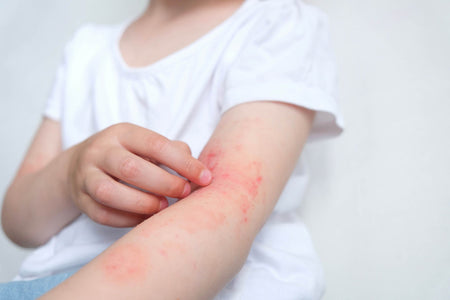- Cat allergies are caused by proteins in cat dander, saliva, and urine, with Fel d 1 being the primary allergen.
- Allergy testing can be done through skin prick tests or blood tests to determine sensitivities.
- Effective treatments include OTC nasal sprays, antihistamines and combination nasal sprays like Allermi for optimal relief.
Do you think you're allergic to cats? For many pet lovers, the idea of being allergic to their furry companions can be tough to face. Allergies to cats and dogs affect 10%–20% of the population worldwide and are becoming a growing public health concern as these rates continue to rise [*].
Yet, many people live with pets for a long time before realizing that their sneezing, watery eyes, or breathing issues might be related to their feline friend. If you already have a pet or plan to adopt one, being aware of cat allergy triggers and symptoms can help you take control of the situation.
What Causes People to Be Allergic to Cats?
People develop an allergic reaction to cats because of proteins found in their dander (dried cat skin flakes), saliva, and urine. The main allergen, Fel d 1, is produced by a cat's skin and saliva [*].
When cats groom themselves, this allergen dries and spreads into the air and clings to furniture, clothes, and other surfaces. This explains why someone with a cat allergy experiences symptoms — their immune system overreacts, treating the allergen as harmful and triggering allergy responses.
Research shows that it can take up to 20 weeks for Fel d 1 levels in a household to drop to levels similar to homes without cats, especially in carpeted environments where the allergen tends to persist longer [*].
Related: 7 Ways to Reduce Pet Dander in Your Home
Cat Allergy Symptoms
Symptoms of cat allergies can range from mild to severe, depending on the individual and the level of exposure. Mild symptoms may include:
- Frequent sneezing
- Redness and itching in the eyes
- Runny or stuffy nose
- Wheezing and coughing
- Hives or rashes
- Redness or itching where a cat has licked or scratched
The severity of symptoms can differ for each person, but 20-30% of people with asthma may have serious reactions when they're around cats. Moreover, allergies to cats may also worsen skin conditions like atopic dermatitis [*].
Testing for Cat Allergies
Testing for cat allergies usually involves either a skin prick test or a blood test.
In a skin prick test, a tiny amount of cat allergen is placed on the skin, often on the forearm or back, and then the skin is gently pricked. If the person is allergic, a small red bump will appear at the test site within 15-20 minutes.
A blood test checks for certain antibodies, like immunoglobulin E (IgE), that react to cat allergens. The skin test is more sensitive than the blood test. It is helpful if a skin test isn't possible or if the person has skin issues that could affect the results.
Both tests help doctors determine if symptoms are caused by a cat allergy and can guide treatments, such as allergy medications or ways to avoid allergens.
Treating Cat Allergies
The good news is that cat allergy symptoms can usually be managed with common allergy medications. Your healthcare provider may recommend the following:
Antihistamines
Antihistamines like cetirizine (Zyrtec), loratadine (Claritin), and fexofenadine (Allegra) are commonly used to manage mild to moderate cat allergy symptoms.
These medications work by blocking histamines, which are chemicals released during an allergic reaction. By preventing histamines from binding to their receptors, antihistamines provide relief from symptoms such as sneezing, itching, and a runny nose.
Related: Allegra vs. Zyrtec: Differences and Alternatives
Nasal Sprays
While antihistamines are effective in reducing symptoms for many individuals, they do not treat the root problem, which is in the nose, like nasal sprays do. These can include corticosteroid nasal sprays and combination nasal sprays.
Corticosteroid nasal sprays, such as fluticasone (Flonase) and triamcinolone (Nasacort), target inflammation and congestion directly in the nasal passages. These sprays reduce swelling and mucus production to improve breathing.
Combination nasal sprays, like Allermi, offer a custom approach to allergy treatment that can be more effective than fixed-dose, single-medication options. These sprays provide long-lasting relief and contain a mix of ingredients — antihistamine, anti-discharge, and anti-inflammatory agents — to address multiple symptoms.
Related: How to Use Nasal Sprays Correctly
Allergy Shots
Allergy shots, or immunotherapy, are used for long-term relief and work by gradually desensitizing the immune system to cat allergens. This process helps the immune system build tolerance over time.
However, keep in mind that allergy shots do not work for everyone. Some patients may not see improvement even after a year of treatment. Speak with your healthcare provider about alternative options.
Tips for Managing Cat Allergies
To manage cat allergies effectively, it’s essential to take proactive steps in your home and lifestyle. Here are some tips to help reduce exposure to cat allergens:
- Take medications before contact. Consider taking medications before coming into contact with a cat to help reduce allergy symptoms.
- Clean regularly. Vacuum carpets, upholstery, and floors frequently, and use a vacuum with a HEPA filter. Wash bedding, curtains, and other fabrics regularly.
- Use HEPA filters. High-efficiency particulate air (HEPA) filters in air purifiers and vacuum cleaners to trap cat dander and reduce airborne allergens.
- Groom and bathe your cat regularly. Regularly bathing and brushing your cat can help reduce the amount of dander they shed. Consider using a pet-friendly allergen-reducing shampoo.
- Create pet-free zones. Designate bedrooms or other areas where you spend a lot of time as pet-free zones to reduce exposure to cat allergens while sleeping.
- Maintain good ventilation. Ensure proper ventilation in your home to help dilute and remove allergens from the air.
- Be cautious with visitors who own a cat. If visitors own a cat, be aware that allergens might cling to their clothes. Consider asking them to wash their hands and change clothes before entering your home, if possible.
When to See a Doctor for Cat Allergies
You should consult a healthcare professional if your cat allergy symptoms interfere with daily activities, such as work or sleep, or if they significantly impact your quality of life.
Additionally, if you have severe symptoms like asthma flare-ups, difficulty breathing, or persistent coughing, a doctor’s evaluation is important.
They can provide a definitive diagnosis, recommend appropriate treatments, and help you develop a management plan tailored to your needs. Early intervention can also prevent complications and improve overall symptom control.
Frequently Asked Questions
As you deal with the challenges of cat allergies, you may have questions about their development, management, and how to find relief.
Below are some frequently asked questions that address common concerns:
Can you suddenly develop an allergy to cats?
Yes, it is possible to suddenly develop an allergy to cats, even if you have never had issues with them before. Allergies can develop at any stage of life, and the immune system can sometimes start reacting to cat allergens even if you previously had no problems.
This change can happen due to various factors, including changes in your immune system or increased exposure to allergens. For instance, cumulative exposure over time may sensitize an individual who previously tolerated cats without issues.
Are there hypoallergenic cat breeds?
There are no completely hypoallergenic cat breeds, but some breeds are known to produce fewer allergens and may be better for people with allergies. Breeds like the Siberian, Balinese, and Devon Rex are often recommended for allergy sufferers due to their lower allergen levels and less shedding.
However, individual reactions can vary, so spending time with a specific cat breed before adopting is a good idea to see how your allergies respond.
How long do cat allergy symptoms last?
The duration of cat allergy symptoms can vary widely depending on factors like the severity of the allergy, the level of exposure to cat allergens, and the effectiveness of treatment.
In general, symptoms can persist as long as you are exposed to cat allergens. If you are consistently around cats, symptoms such as sneezing, itching, and a runny nose might continue indefinitely.
However, if you manage to minimize exposure or use effective treatments, symptoms can improve or even subside.
The Bottom Line
Dealing with cat allergies can be tough, especially if you love having cats around. It's important to know what causes these allergies, what symptoms to look for, and how to test for and treat them.
You can't completely stop allergies from happening, but you can take steps to make things better. If you’re struggling with cat allergies, consider trying Allermi — a cutting-edge combination nasal spray designed to provide fast and effective relief.
References:
- Chan, S. K., & M. Leung, D. Y. (2018). Dog and Cat Allergies: Current State of Diagnostic Approaches and Challenges. Allergy, Asthma & Immunology Research, 10(2), 97-105. https://doi.org/10.4168/aair.2018.10.2.97
- Dabrowski, A. J., Van der Brempt, X., Soler, M., Seguret, N., Lucciani, P., Charpin, D., & Vervloet, D. (1990). Cat skin as an important source of Fel d I allergen. The Journal of allergy and clinical immunology, 86(4 Pt 1), 462–465. https://doi.org/10.1016/s0091-6749(05)80200-3
- Satyaraj, E., Wedner, H. J., & Bousquet, J. (2019). Keep the cat, change the care pathway: A transformational approach to managing Fel d 1, the major cat allergen. Allergy, 74(Suppl 107), 5-17. https://doi.org/10.1111/all.14013
- Sparkes, A. H. (2021). Human allergy to cats: A review for veterinarians on prevalence, causes, symptoms and control. Journal of Feline Medicine and Surgery, 24(1), 31-42. https://doi.org/10.1177/1098612X211036793









